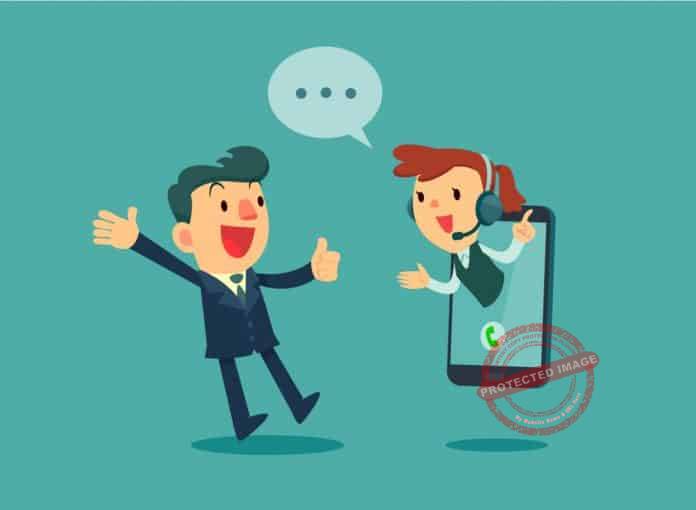Communication has always been a very important subject for individuals and businesses and hence the need to know how to talk to customers.
Communication is defined as the expressing or sharing ideas, feelings, and information that plays a vital role in our personal lives and our business.
Though the importance of communication in business is often ignored.
It does not eradicate or rule out the need to appropriately exchange information, especially between you and your customers.
This is not just for communication’s sake.
Instead, it is to ensure that services and products are delivered in the right manner.
In this article, we will be sharing the importance of communication with your customers, the tips for communicating with your customer, and how you can communicate with your customer appropriately.
First, we must know who a customer is.
How to Talk to Customers; Who is a Customer?
A customer, also known as a client buyer or purchaser in some cases, is an individual who is a recipient of a good service or product from a seller, vendor, or supplier through a financial transaction.
A customer can also be defined as an individual or a group of individuals who purchase or receive products and services from other individuals, companies, or businesses.
There are different types of customers.
Also, the business’s products and services are the pillars and foundation of every business.
So, there will be no business without customers, no sale of products or services to offer.
Hence, the reason why you should create a proper communication channel or relationship with them for your business growth.
How to Talk to Customers – Importance of Talking to your Customers
As we stated earlier, customers are essential to the growth of every business.
This is why as a business owner, you should ensure that you have a good oral or written communication relationship with your customers.
This could determine the growth or death of your business.
With effective communication, you have the opportunity to build trust and loyalty between your business and customers.
You also stand a chance of gaining more potential customers for your businesses.
Here are some highlighted importance of communication with customers;
Lucidity
Communication helps you to gain clarity and understand the needs and desires of your clients.
Through communication, you can ask the questions that lead to understanding your client’s situation.
It also helps you as a service and product provider know the necessary steps towards fixing your customer problems without any misconceptions.
Communication also helps your customers to understand how your products and services work.
Building Connections and Keeping Customers In the loop
Customers are the foundation of every business, as we started earlier.
So it is not enough to provide products and services for them.
You also need to stay in touch with them as well as keep them informed.
Without constant communication between you and your customer, there is a tendency that they might forget about your business or think that you do not care for the needs of your customers.
Emails and newsletters containing thank you notes, discount offers, and bonuses, and information on new products and services, are a great way to stay in touch with and keep your customers informed.
Resolving Complaints
Communication is a great way to deal with your customer’s complaints and attend to their needs.
Attending to the needs of your customers is an essential part of your business.
Via effective communication, you can effectively follow up on the customer’s complaints while trying to remedy the situation as quickly as you can.
Customers can only trust a business that handles their complaints and needs with all forms of professionalism or internationality.
Any lackadaisical action or approach on your part can lead to a customer being dissatisfied and disappointed.
A dissatisfied customer can hurt the growth of your business as their remarks and comments can discourage others from patronizing you.
Loyalty and Trust
As a product or service provider, your customers or buyers must trust you.
They should know that they can reach out to you in cases of feedback and inquiries.
Additionally, they should trust in your ability to respond to their needs as quickly as possible.
Effective communication between you and your customers creates a platform for trust and loyalty to be built based on your availability and proactiveness.
Building Relationships
As professional as business transactions may be, there is always room for building relationships, trust, and bonds all through communication.
Communication helps you to know more about your client or customers and vice versa.
It allows your business transactions to flow easily and effectively.
Transparency
Effective communication brings about transparency.
Transparency is essential between every business and its customers as it assures your customers of your honesty and accuracy.
This is done by providing them with all the necessary information they need to do about your business.
This could be in terms of cost, how your products and services work, and other updates on your business that could be beneficial to them or not.
Executing Change
One of the importance of constantly communicating with your customers is that it helps you attend to their ever-changing needs.
A business that commits to communicating with its customers can change or upgrade its products and services to meet the customers’ current needs.
New Ideas for Products and Services
When it pertains to business communication, you will come across various customers from different backgrounds with different ideas.
As you communicate with each of these customers and receive their feedback, it only helps you serve them better.
It provides you with different and new ideas on modifying, improving, and creating new products and services.
How to Talk to your Customers – Risks of not Talking to your Customers
Effective communication helps you build trust and loyalty with your customers, alongside a good customer relationship.
However, a lack of communication or information between you and your customers can lead to certain risks and endangering possibilities.
These risks include;
Displeased and Unhappy customers
One of the risks of poor communication between you and your customer is that rather than having happy and satisfied customers, you have the dissatisfied, displeased, or unhappy customers whose expectations and needs were not met.
This could be when delivery was not done at the stipulated time or sent the wrong product to the customer.
Also, it can happen when you give the wrong response or solution to a customer’s problem due to miscommunication.
Bad Customer Relationship
When the communication between you and your customers is poor, there would be no room to create a good customer relationship.
Instead, you will have little or no customer relationship at all.
This is because customers will conclude that your business or brand does not care about its customer’s needs or solve its customers’ problems.
They will also conclude that you are not providing your customers with the best results and services.
Losing Customers
Losing your customers is one of the risks you stand to encounter when you don’t know how to talk to your customers.
Rather than retaining customers, you tend to lose your preexisting customers and the possibility of gaining any new customers.
When customers cannot reach you to ask questions, make inquiries, place orders or receive updates on your products and service, they move on to patronize other businesses that provide such opportunities and platforms for them to communicate.
Distrust and Doubt
If your customers do not have the adequate information they need to know about your products and services, it leads to distrust and doubts about your business.
When a customer begins to doubt your business’s effectiveness and abilities to deliver its products and services adequately, they do not become loyal customers.
Rather, they patronize other businesses and brands your competitors.
Reduction In Profit
Additionally, poor communication puts you at risk of losing your customers.
It also prevents you from making any increase in your profits.
A decrease or reduction in your profits prevents your business from growing and making the expansion you hope to make.
Instead of making profits, you incur extra expenses in marketing and advertising to get new customers.
Tips on How to Talk to Customers
As important as communication is to every business, it is also important to know that successful and effective communication is the way to achieve a great result.
There are certain ways you can use effective communication to meet your customer’s needs while avoiding misunderstandings and misconceptions.
Here are some tips to help you talk to your customers effectively:
Use Positive Language
While talking to your customer, you must ensure that your chosen language is positive to keep the conversation going smoothly.
Languages that can result in conflict or miscommunication should be avoided.
Negative words as “can’t,” “won’t,” ‘didn’t,” and “you should” can seem negative.
You should strive to turn a negative conversation into a positive conversation by telling your clients what you intend to do about their current situation rather than telling them what you cannot do.
Languages like “we intend to rectify,” “we would put in place the perfect solution” would come in handy while communicating with a customer.
Greet Properly
One of the great ways to start a big conversation with your customer is to greet them properly and appropriately.
By greeting them properly, you should ensure that you are polite, professional, and formal.
This shows that you value and respect your customers.
Words like; “hello,” “welcome,” good morning/afternoon/evening,” ‘how may I/we help you?” would go a long way in helping you communicate with your client.
Define your Tone and Voice
Using the right tone of voice is crucial to communicate effectively with customers.
Your tone gives your customer an idea of your company’s image.
Defining your tone and voice allows you to give a personal touch while talking to your customers.
This ensures communication is done without sounding robotic or rude.
Understanding and Responding to Your Customer’s Needs
While communicating with your customers, you should ensure that you understand their needs.
Understanding their needs could involve researching your customers as they vary from one another.
The purpose of communication with your customer is to satisfy their needs, so you must understand what the conversation is about.
Listen and Always Listen
Another great way to talk to your customer is to listen more than you speak.
Rather than trying to convince your customer or clients, try listening to them.
This is so you can understand their questions and their request.
Avoid interruptions as they can trigger or upset your clients, and they can also make your clients feel less valued or disrespected.
Attention to Details
While communicating with your customers, be as attentive as possible.
Your responses should directly address their needs and personality.
Hence, you must be sure that you get their details right.
You should write down their names, requests, and complaints without any form of error, omission, or typography.
An error could indicate neglect on your part to the customer involved.
Take Responsibility
The phrase “customers are always right” seems to be a cliché.
However, it is essential when you are communicating with your customer, especially when something bad happens.
Rather than shifting blames, take responsibility for the situation, apologize and figure out a way to solve it.
This does not only help you to retain your customer, but it also creates a good relationship between you and your customer.
Be Patient
Patience is a virtue.
Also, it really comes in handy when talking with your customer.
This is true, especially where the customer is upset or disappointed.
It may also be the situation where there was a miscommunication, and your customer is in being rude.
You must respond to the need of the customer without feeling the need to retaliate.
This allows you to render the best services without ruining your relationship with your customers.
Be Honest
As much as you hope to satisfy your client’s needs by communicating with them, you should also be honest while you are in it.
Sugarcoating the truth while giving your customers information about your products and services is never the right way to go about it.
Distrust and lies can result in the customer doubting your products, services, and integrity as a business.
In cases of issues and delays, it is essential that you diplomatically keep your customer in the loop.
This helps your customer to build trust and confidence in your abilities to deliver.
Ways to Communicate or talk to Customers
With the constant innovations of computer technology, there are simple and effective ways to keep in touch with your customer while ensuring that you attend to their needs appropriately.
These ways and methods vary depending on your type of business and the kind of customers you intend to communicate with.
These communication methods help you give the best customer service to your customers.
Some of these communication methods include;
Emails
Emails, also known as electronic mails, are a method in which you can use to send messages and exchange information with your customer.
It helps you to communicate in a manner that suits your customer’s time and captures your customer’s attention.
This is because they include brief messages with subjects and titles that give your customer an idea of what the message entails.
Examples of email platforms that you can use are Gmail, Microsoft Outlook, and ProtonMail.
Others are AOL mail, Zoho mail, Yahoo Mail Hotmail, I-cloud mail, etc.
Newsletters
Newsletters are another great effective way to communicate with your customer.
They are electronic or printed periodical reports or bulletins.
These can be issued to your customers with information regarding your products and services.
These letters help you to reach out to your customers who are not on other communication platforms.
Additionally, it helps you to receive feedback from them.
Newsletter platforms you could consider at HubSpot email newsletter Tool, Benchmark, Moosend, SendInBlue, Get responses, etc.
Website
Creating a website for your business is another way in which you can communicate with your customers.
The web pages allow your customers to have all the necessary information they need for your products and services.
It also allows them to place orders on your products and services at a time that is convenient for them.
The website also allows them to drop their questions or inquiries in the comments section.
Website platforms that you can use include; WordPress.org, WordPress.com, domain.com goddaddy.com, Wix, Shopify, etc.
Web Chats
WebChats are software applications that allow your customer to communicate with you in real-time.
It enables you to answer questions and resolve issues at a time that your customer needs them.
It is a very easy way for you to give your customers the assistance that they need.
Webchat platforms include HubSpot Live Chat, Live Chat, Zoho desk, Podium, Freshchat, Intercom, etc.
Hand-written Letters
Granted, software programs are very effective in communicating.
However, you should not rule out the option of sending handwritten notes to your customers.
For businesses whose customers do not make use of the internet, you should consider communicating with handwriting notes.
These handwritten notes could be in the form of complimentary greetings or thank you cards.
Social Media
It is advisable that you set up social media accounts for your business for growth.
Social media allows you to communicate with your customers as well as promote your products and services.
It allows you to reach your target audience and potential customers through the use of hashtags.
Social media platforms that you could use include; Facebook, Twitter, Instagram, LinkedIn, etc.
Video Calls and Messages
Communicating with your customers is not limited to text emails or letters.
Video calls and messages are also great alternatives.
Video calls make communication easier and simpler.
It helps you to build personalized relationships with your clients.
Some Video call and messages platforms you should consider are Skype, Zoom, Microsoft Teams, Go to meetings, EZ talks, Starleaf, etc.
Voice Calls
An alternative to video conversations could be voice conversations.
Voice calls also allow you to communicate with your customers in real-time.
Voice calls can also be recorded for you to listen again and provide your customers with the best solutions.
Additionally, they allow your customers to place a call through to you via your network service provider.
Mobile Phone Technology
Mobile phone technology helps businesses create automated options that provide answers and solutions to their client’s needs.
In addition to that, it directs your clients to the right person who would attend to their needs.
Text Messaging
A text message is another great way to communicate with your customers regardless of your business size.
These text messages could contain information about your product, services, orders, deliveries, etc.
Text messaging could also allow your customers to text you if they have a need.
Conclusion on How to Talk to Customers
Mastering the right way to talk to your customer can give your business, company, or organization the elevation and expansion it needs.
This is because it ensures that your customers are satisfied.
One satisfied customer creates room for more customers.
With these tips and methods, be rest assured that your business would receive positive feedback from its customers and clients.









